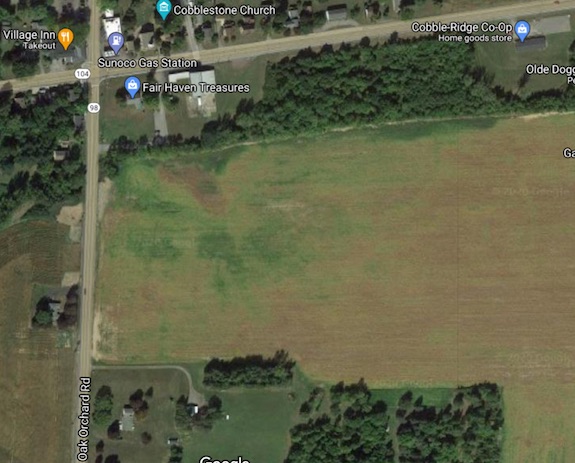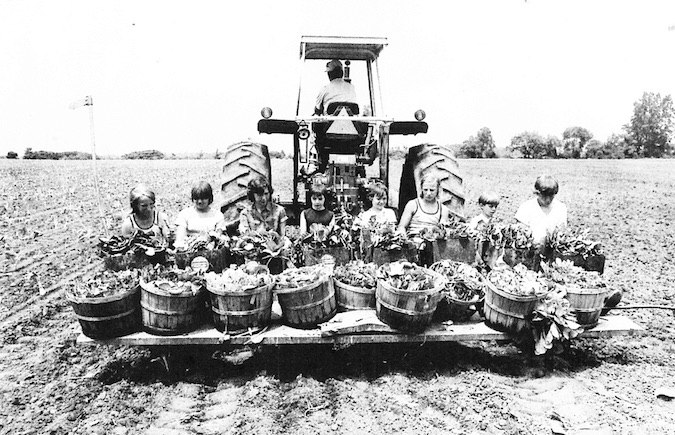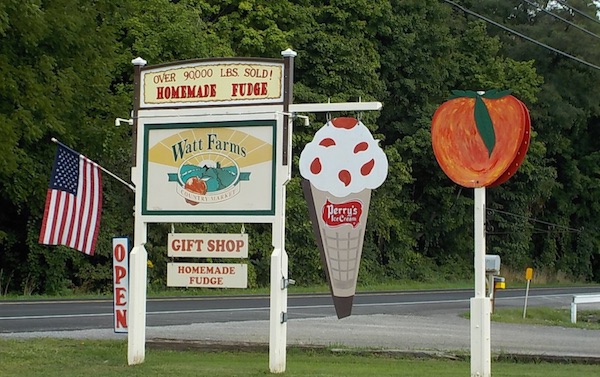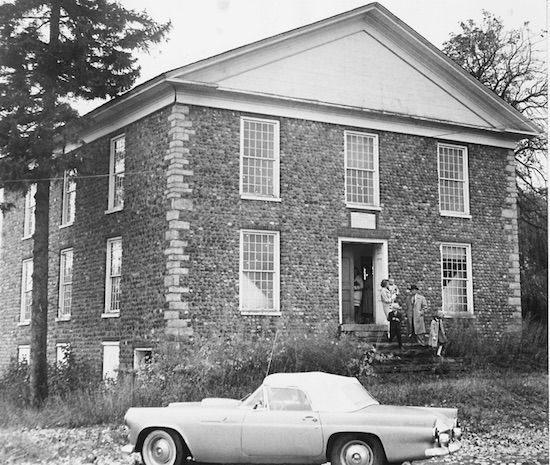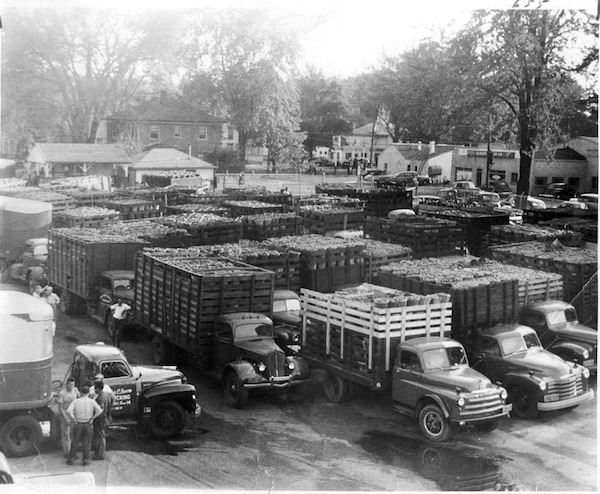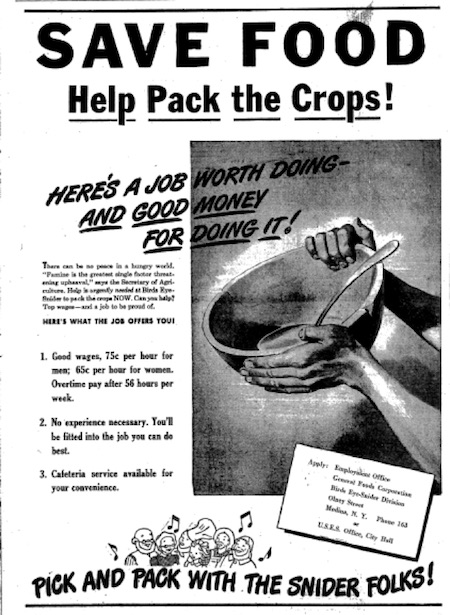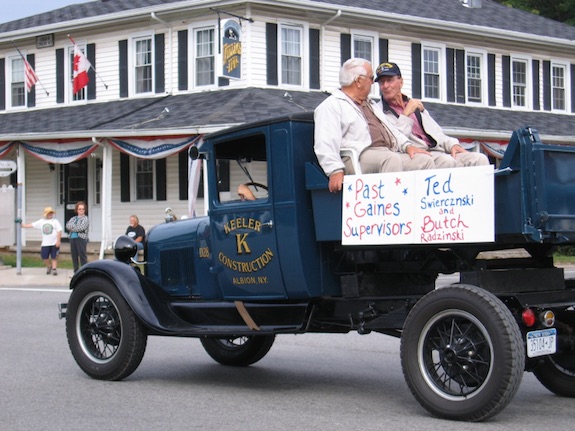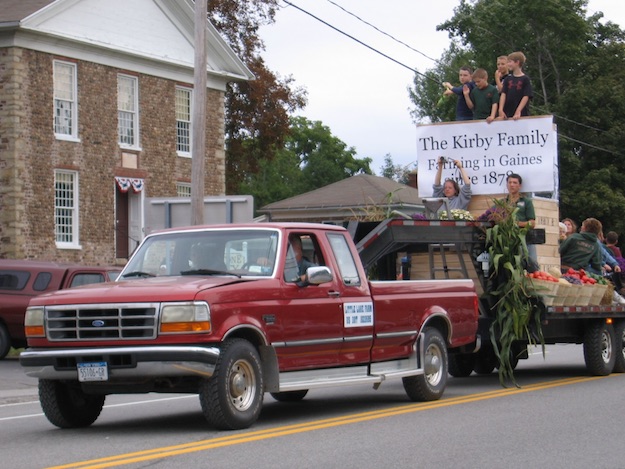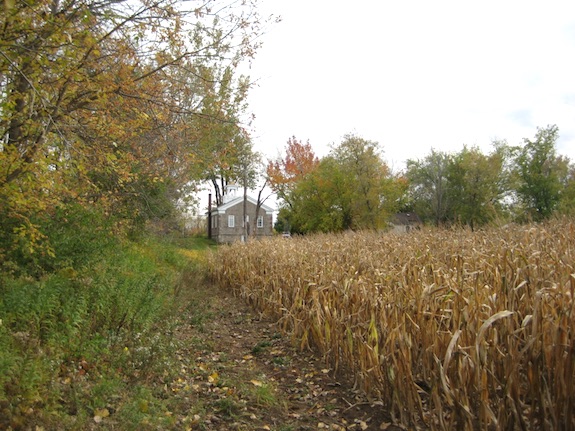Historic Childs: History of Agriculture, Part 6 (a focus on the Swierczynski family)
Loss of processing plants in Albion hurt family farms in Childs
By Doug Farley, Cobblestone Museum Director

Ted Swierczynski in 1966
GAINES – Stanley Swierczynski got involved with farming in Gaines during the Great Depression. In 1950 he and his son Frank acquired 104 acres in the Hamlet of Childs on the south side of Ridge Road.
Later, Frank’s brother Ted got involved in the farm in the 1950s after he came home from the Korean War. The principal crops in the region at the time were tomatoes and cucumbers. They operated under the banner of Fair Haven Farms.
Fair Haven also had a small peach orchard across from the Cobblestone School. During this time period most local farmers sold peaches at the side of the road. Ted said, “It was easier then, less regulation.”
Ted Swiercznski remarked, “We later acquired or rented more land to eventually farm a couple thousand acres in the region. We had to use migrant farm labor out of the southern states. Still in need of even more laborers, we bussed in about 200 laborers a day from Rochester to hand pick snap beans and tomatoes.”
Ted Swiercznski considered his farm to be a family operation, seen here in 1977 driving tractor with the help of a few neighbors to round out his cabbage planting team. Manning the planter were (left to right) John Stirk, Colleen Swiercznski, Maureen Swiercznski, Cathy Swiercznski, Chris Swiercznski, Tim Stirk, Patrick Swiercznski and Tod Swiercznski.
Chris and Karen Watt are well known in the local farming community. In addition to their Farm Market at Five Corners, they have maintained orchards in Childs, too. In 1990, Chris took over farming Eugene Leigh’s apples on Route 98 and also his pears on the south side of Route 104 in Childs.
Chris said the Farm Market got started with a tent by the side of the road. In the 1980s, he and Karen worked under a tent for several years and then decided to build the Watt’s Farm Country Market to avoid the elements. They later added the ice cream stand. Watt Farms sells a large variety of local fruit including apples, pears, cherries, peaches, strawberries and melons. Chris said, “We farmed a total of seven different farm orchards.”
When questioned about the future, Chris said, “What we used to call a farm, is nothing but a field today.” Farms are getting bigger and bigger. “I’m winding down. I’ve got no kids who are interested in farming, so the operation might eventually become part of a larger farm. I’ve held the same job for 40 years. How many people can say that?”
In a small way, even the Cobblestone Museum can trace its own roots to a history of agriculture in Childs. In the period 1930-1960, before the Cobblestone Society was formed, the Cobblestone Universalist Church was rented out by the Balcom Brothers, Walter and Oris, to store cabbage in the church basement. Mike Zambito, who operated Zambito Produce across the street from the church reflected on this. “The Balcom’s were notorious for storing cabbage in every available space. They rented out every conceivable nook and cranny they could to store cabbage. They filled the space by hand, starting by laying down straw and then stacking cabbage on top of that up to the rafters.”
He recalled that the cabbage was delivered using 10 wheelers or “canvas trucks.” He said, “Those old trucks had charcoal heaters.” Years of cabbage storage had taken a toll on the Cobblestone Church and one of the early tasks that the Cobblestone Society tackled in the early 1960s in preparation for public tours was adding a concrete floor to the Church basement.
Photo courtesy Orleans County Historian
In its heyday, most local farms sold their tomatoes to Snider Packing in Albion which became a part of the Birdseye Division of General Foods in 1943, and then became Hunt-Wesson. An early morning delivery tie-up at the Snider plant is shown here in the 1950s. Ketchup, chili sauce and tomato paste were the principal products produced here.
Albion also had Dailey’s sauerkraut plant which processed 500 tons of cabbage each year and employed 100 workers. A canned cherries plant and several other local food plants thrived in the area following WWII including Comstock, Duffy-Mott, Lipton, Forman’s Pickles, Tree Pickles and H. J. Heinz.
The large food processing plants in Albion left the region in the 1960s and moved on to greener pastures in California. Ted Swiercznski said, “In the late 60s and 70s it all disappeared. Albion couldn’t compete with the better weather and longer growing season in California.” Local farmers also needed to find hundreds of hired hands to harvest their crops, and finding those hand laborers became increasingly more difficult. Machines were used to harvest the crop in California, making it much easier and cheaper to process food there instead.
Food processing plants, just like the farmers, had a hard time securing enough labor to package the food products. Here, in 1946, Snider Packing is shown with one of their expensive full page newspaper ads that they used each week to try to get workers to process all of the crops that farmers took to the plant. Snider Packing supplemented its labor force during WWII by operating a prisoner-of-war facility behind their plant. German war prisoners were barracked on site and used as laborers in the food plant. Similar provisions were used in nearby Medina, as well as Youngstown in Niagara County where prisoners were housed in special barracks at Fort Niagara and were used to harvest the fruit crops.
An employee badge from Snider Packing is shown here. The demise of the local processing plants eventually led to the end of the small family farm era in Childs, too. Orleans County IDA administrator Raymond Pahura remarked in 1977 that the region had been lulled into a false sense of complacency in the post WWII years. He said, “I can remember a few years back when people were smug about our employment situation. Heinz, Hunt-Wesson, Duffy-Mott and Birds-Eye were fixtures in our community. We woke up one morning and they were all gone.”
Ted Swiercznski eventually sold his farming interests in 1981. He also served as Town of Gaines Supervisor, along with Ron Radzinski (left), who are both seen here in Childs participating in the Town’s Bicentennial Parade in 2009.
Agriculture in the Hamlet of Childs is now continued in part by Kirby Farms. Their lineage is traced to brothers Robert, John, Francis and George Kirby. Now, Bob’s son Jim is farming both sides of Ridge Road in Childs, along with his son Adam.
Sadly, for the most part, the era of small family farms came to an end in the 1970s and large corporate farms took their place. In Childs, the Zambito, Albanese and Swiercznski families actually joined forces to form ZAS Inc. to continue the farming tradition into the transition years. The three local farming families purchased an old building on Route 31 (across from current day Tops Market) where A&P Packing packaged onions and potatoes during the 1960s and 70s.
The Swiercznski family legacy continues in the region today operating in conjunction with Dragan Farms headquartered in Albion. Dragan principals, Steven Swiercznski and his cousin Tod Swierczynski, are farming about 2,000 acres of soybeans and wheat in the region with Dragan Farms.
Jim Kirby has continued his family’s farming legacy stretching back to 1878, including tending this field of corn behind the Cobblestone District #5 Schoolhouse in Childs.



























